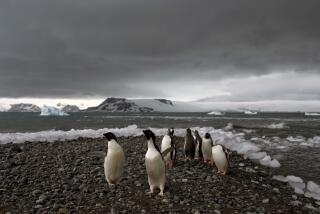Glaciers in southern China receding rapidly, scientists say
Reporting from Lijiang, China — If you want to see a glacier melt with your bare eyes, try Yulong Snow Mountain, an 18,000-foot peak in southern China’s Yunnan province.
On this early December morning, the mountain is etched against the technicolor sky in shades of gray -- definitely more gray than white. Naked boulders of limestone and daubs of shrubbery protrude from the shallow snow cover.
At a scenic overlook on the way up, tourists leave their woolly hats in the tour bus when they hop out to take photographs.
Even with its bald spots, the mountain is a picture postcard. But scientists worry about the way it is changing.
“Look here,” said Du Jiankuo, a 25-year-old Chinese scientist, raising his telephoto lens to a gray patch. “You can see where we lost another big chunk of ice.”
In the study of climate change, glaciers are sometimes likened to the canaries in the coal mine, and to many observers the condition of Yulong (“Jade Dragon”) mountain is troubling.
He Yuanqing, one of China’s leading glacier experts, found that the mountain’s largest glacier, known as Baishui No. 1, has retreated about 275 yards since 1982.
“At this rate, the glacier could disappear entirely over the next few decades,” said He, who heads a team of scientists who have been studying Yulong mountain since 1999 for the Cold and Arid Regions Environmental and Engineering Research Institute, a government-run think tank.
Anywhere from five to 20 scientists work here at any given time -- planting sticks in the drifts to measure snow accumulation and taking time-lapse photographs of the retreating snows and the advancing tree line up the mountain.
Yulong Snow Mountain is a fitting object for their obsession: It has the southernmost glaciers on the Eurasian continent. Its location at the edge of the Tibetan plateau is also critical.
By some calculations, the plateau contains the largest repository of ice outside the Arctic and Antarctic -- so much so that it is sometimes nicknamed the “third pole.” It is also the origin of many of Asia’s great rivers -- among them the Yangtze, the Mekong and Ganges -- supplying water to more than 1 billion people.
“People are dependent on these glaciers for water and it would have a huge impact on their lives if they disappeared,” said He.
The Tibetan plateau is also extremely vulnerable to global warming. The China Meteorological Administration calculates that temperatures on the plateau have risen an average of 0.58 degrees Fahrenheit per decade, more than four times the average warming rate in China as a whole.
“A plateau is almost like a frying pan in the sky. It has to do with the way the land interacts with the atmosphere. Everywhere in the world, the mountains are heating up faster than the lowlands,” said Barry Baker, a climate change expert with the Nature Conservancy, who is also studying the glaciers in Yunnan province.
One of the fastest vanishing glaciers in the world is Mingyong glacier on Mt. Kawagebo, a sacred peak for Tibetan Buddhists. Out of religious sensitivity, scientists have not been permitted to work on the mountain. But through photographs they have observed that the tongue of the glacier -- the farthest flung reach of snow -- has retreated more than a mile and a half up the mountain.
When glaciers disappear, they don’t necessarily go quietly. The ice becomes unstable; gentle slopes of snow erode into steep ridges that can collapse at unpredictable times. Yulong has had two such avalanches recently -- one in 2004 and another over the summer.
“There are so many cracks in the ice that it could become dangerous soon for us to continue our work on the mountain,” said scientist Du, who is part of the team working at Yulong.
In the near term, the effects of the warming temperatures are a mixed blessing. In a nearby village, called Baisha, cafe tables are set out on the sidewalk to allow tourists to bask in the sunshine. Tiny plots of cabbages are kept well irrigated by the water spilling down from the mountain.
For the residents, most of them members of the Nakhi ethnic minority, there is much confusion about the changes in the climate.
“Electricity, tourists, global warming, we don’t know why, but it is getting warmer and we don’t have the snow that we used to,” said 56-year-old He Shengxian, her feet sinking into the mud as she carried a bale of hay alongside a swollen stream.
A farmer, Huang Xiaoquan, 53, says he is certain that the disappearance of the ice is “nature’s punishment” against modern life.
“But there’s nothing we can do about it, so why worry?” said Huang.
More than 1 million tourists, most of them Chinese, visit Yulong every year. Situated just outside the quaint tourist town of Lijiang and equipped with a cable car, Yulong has some of the most accessible glaciers in China.
In the park leading to the mountain, administrators have put up signs aimed at educating the public about global warming. The scientific team studying the glacier also intends to build a research station near the mountain and to open an exhibit to help tourists understand why they should worry about melting glaciers.
“Of course I’m concerned that the glaciers are disappearing,” said Ye Xiaochen, 47, a factory worker from Sichuan province who was wearing new hiking gear and carrying a Japanese camera on a tour of Lijiang. “It’s not true that Chinese only care about the economy -- the environment is equally important.”
To prove his point, he turned to a colleague and snapped, “Put out that cigarette -- you’re making more pollution.”
Nicole Liu of The Times’ Beijing Bureau contributed to this report.
More to Read
Sign up for Essential California
The most important California stories and recommendations in your inbox every morning.
You may occasionally receive promotional content from the Los Angeles Times.










